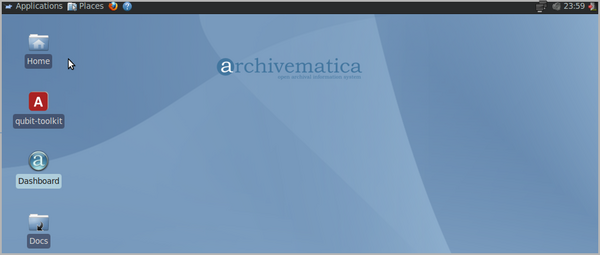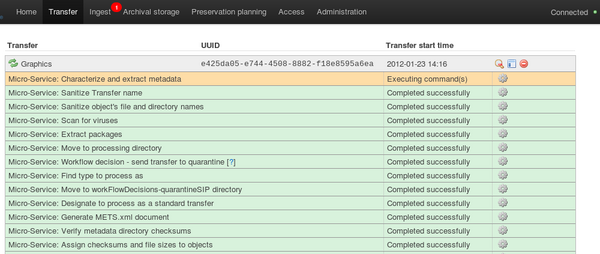Difference between revisions of "UM transfer"
| Line 6: | Line 6: | ||
== General description == | == General description == | ||
| − | During transfer, digital objects | + | During transfer, the user moves digital objects from source directories accessible via the MCP server into Archivematica, where the transfers run through several micro-services: UUID assignment; checksum verification (if checksums are present); package extraction (i.e. unzipping of zipped or otherwise packaged files); virus checking; indexing; format identification and validation; and metadata extraction. For a definition of "transfer", please see the [[UM glossary|Glossary]]. </br> |
At the end of transfer, the user creates a SIP from one or more standard transfer(s). Once this is done, the SIP is moved into ingest. | At the end of transfer, the user creates a SIP from one or more standard transfer(s). Once this is done, the SIP is moved into ingest. | ||
Revision as of 13:43, 23 August 2012
Main Page > Documentation > User manual > User manual 0.9 > Transfer
General description
During transfer, the user moves digital objects from source directories accessible via the MCP server into Archivematica, where the transfers run through several micro-services: UUID assignment; checksum verification (if checksums are present); package extraction (i.e. unzipping of zipped or otherwise packaged files); virus checking; indexing; format identification and validation; and metadata extraction. For a definition of "transfer", please see the Glossary.
At the end of transfer, the user creates a SIP from one or more standard transfer(s). Once this is done, the SIP is moved into ingest.
If your transfer is a DSpace export, please see DSpace export.
If your transfer is a CONTENTdm export, please see CONTENTdm export
If your transfer is a bag or a zipped bag, please see Bags
If your transfer is an email transfer, this feature is still under development, please see [[]]
If your transfer is composed of objects that are the result of digitization, please see Digitization output.
Create a transfer
- See Administrator manual for instructions on how to set up shared source directories.
- Open the web browser and the Archivematica dashboard (figure 1).
Option 1
Use this option if you do not wish to structure your transfer using the file browser or include submission documentation.
- In transfer tab, name your transfer.
- Browse to a source directory and select your object or set of objects for upload. Your transfer can be composed of multiple directories and files from different source directories. Repeat this step if your transfer is composed from multiple sources.
- Once all of your sources have been uploaded, hit the Start Transfer button for the transfer processing to begin.
Option 2
Use this option if you wish to compile your objects and/or directories into a folder ready for processing using the file browser interface.
- Navigate to a directory of files to be preserved.
- Right-click the directory and select "Restructure for compliance" (figure 4). This will create a structured directory containing the subdirectories required to transfer the files into Archivematica: logs, metadata, objects. You can create subdirectories within objects if desired.(Note that in Option 1, these subdirectories were automatically generated when you hit Start Transfer)
- If you would like to add Submission Documentation, in the transfer you have just created, navigate to the /metadata/submissionDocumentation folder and add files if desired. These files could be donor agreements, transfer forms, copyright agreements and any correspondence or other documentation relating to the transfer. Any SIPs subsequently made from this transfer will automatically contain copies of this documentation.
- To upload your transfer into Archivematica and begin processing, follow the steps in Option 1.
Process the transfer
- In the dashboard transfer tab, the transfer will appear in the dashboard with a bell icon next to it. This means that it is awaiting a decision by the user.
- Click on the micro-service to display jobs that have completed, including the one requiring action.
- In the Actions drop-down menu, select "Approve transfer" to begin processing the transfer (figure 5). You may also "Reject transfer" and quit processing.
- The transfer will now run through a series of micro-services. These include:
- Verify transfer compliance (verifies that the transfer is properly structured - i.e. with the logs, metadata and objects folders)
- Create transfer UUID (assigns a unique universal identifier for the transfer as a whole)
- Assign file UUIDs to objects (assigns a unique universal identifier to each file in the /objects directory)
- Verify metadata directory checksums (verifies any checksums included with the transfer)
- Assign checksums to objects (assigns a sha-256 checksum to each file in the /objects directory)
- Generate METS.xml document (creates a METS file capturing the original order of the transfer. This METS file is added to any SIPs generated from this transfer)
- Extract packages (extracts contents from zipped or otherwise packaged files)
- Sanitize object's file and directory names (removes prohibited characters from folder and filenames, such as ampersands)
- Scan for viruses (scans for viruses and malware)
- Characterize and extract metadata (identifies and validates file formats; extracts technical metadata embedded in the files)
- Index transfer (Indexes transfer)
- A transfer that is in the middle of processing will show which micro-services have been completed (green) and which are in progress (orange) (figure 6).
- When a micro-service fails or encounters an error, the micro-service background turns from green to pink and a "failed" icon appears next to the transfer or SIP name. See Error handling for more information about how to handle an error.
- Once the transfer micro-services are completed, a bell icon will appear next to the transfer. This means that the transfer is ready to be packaged into a SIP for ingest (figure 7). See Ingest for next steps.



